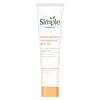Simple Skincare Protect 'N' Glow Triple Protect Moisturizer SPF 30 Versus Altruist Dermatologist Sunscreen SPF 30
What's inside
What's inside
 Key Ingredients
Key Ingredients

 Benefits
Benefits

 Concerns
Concerns

 Ingredients Side-by-side
Ingredients Side-by-side

Water
Skin ConditioningEthylhexyl Methoxycinnamate
UV AbsorberGlycerin
HumectantDimethicone
EmollientCaprylic/Capric Triglyceride
MaskingZinc Oxide
Cosmetic ColorantIsopropyl Myristate
EmollientIsohexadecane
EmollientSteareth-21
CleansingCetearyl Alcohol
EmollientDimethicone Crosspolymer
Emulsion StabilisingSodium Ascorbyl Phosphate
AntioxidantTocopheryl Acetate
AntioxidantZingiber Officinale Root Juice
Skin ConditioningSteareth-2
EmulsifyingPhenoxyethanol
PreservativeAmmonium Acryloyldimethyltaurate/Vp Copolymer
Glyceryl Stearate
EmollientCaprylyl Glycol
EmollientXanthan Gum
EmulsifyingPolyhydroxystearic Acid
EmulsifyingCitric Acid
BufferingDisodium EDTA
Niacinamide
SmoothingCyclopentasiloxane
EmollientBHT
AntioxidantWater, Ethylhexyl Methoxycinnamate, Glycerin, Dimethicone, Caprylic/Capric Triglyceride, Zinc Oxide, Isopropyl Myristate, Isohexadecane, Steareth-21, Cetearyl Alcohol, Dimethicone Crosspolymer, Sodium Ascorbyl Phosphate, Tocopheryl Acetate, Zingiber Officinale Root Juice, Steareth-2, Phenoxyethanol, Ammonium Acryloyldimethyltaurate/Vp Copolymer, Glyceryl Stearate, Caprylyl Glycol, Xanthan Gum, Polyhydroxystearic Acid, Citric Acid, Disodium EDTA, Niacinamide, Cyclopentasiloxane, BHT
Water
Skin ConditioningC12-15 Alkyl Benzoate
AntimicrobialEthylhexyl Salicylate
UV AbsorberButyl Methoxydibenzoylmethane
UV AbsorberEthylhexyl Stearate
EmollientOctocrylene
UV AbsorberGlycerin
HumectantPhenylbenzimidazole Sulfonic Acid
UV AbsorberCetearyl Alcohol
EmollientGlyceryl Stearate
EmollientTitanium Dioxide
Cosmetic ColorantTris-Biphenyl Triazine
UV AbsorberAcrylates/C10-30 Alkyl Acrylate Crosspolymer
Emulsion StabilisingPanthenol
Skin ConditioningCaprylyl Glycol
EmollientButylene Glycol
HumectantPropylene Glycol
HumectantDecyl Glucoside
CleansingXanthan Gum
EmulsifyingPiroctone Olamine
PreservativeSodium Cetearyl Sulfate
CleansingSilica
AbrasiveDisodium Phosphate
BufferingDiethylhexyl Sodium Sulfosuccinate
CleansingSodium Hydroxide
BufferingPhenoxyethanol
PreservativeSilver Chloride
PreservativeWater, C12-15 Alkyl Benzoate, Ethylhexyl Salicylate, Butyl Methoxydibenzoylmethane, Ethylhexyl Stearate, Octocrylene, Glycerin, Phenylbenzimidazole Sulfonic Acid, Cetearyl Alcohol, Glyceryl Stearate, Titanium Dioxide, Tris-Biphenyl Triazine, Acrylates/C10-30 Alkyl Acrylate Crosspolymer, Panthenol, Caprylyl Glycol, Butylene Glycol, Propylene Glycol, Decyl Glucoside, Xanthan Gum, Piroctone Olamine, Sodium Cetearyl Sulfate, Silica, Disodium Phosphate, Diethylhexyl Sodium Sulfosuccinate, Sodium Hydroxide, Phenoxyethanol, Silver Chloride
 Reviews
Reviews

Ingredients Explained
These ingredients are found in both products.
Ingredients higher up in an ingredient list are typically present in a larger amount.
Caprylyl Glycol is a humectant and emollient, meaning it attracts and preserves moisture.
It is a common ingredient in many products, especially those designed to hydrate skin. The primary benefits are retaining moisture, skin softening, and promoting a healthy skin barrier.
Though Caprylyl Glycol is an alcohol derived from fatty acids, it is not the kind that can dry out skin.
This ingredient is also used as a preservative to extend the life of products. It has slight antimicrobial properties.
Learn more about Caprylyl GlycolCetearyl alcohol is a mixture of two fatty alcohols: cetyl alcohol and stearyl alcohol. It is mainly used as an emulsifier. Emulsifiers help prevent the separation of oils and products. Due to its composition, it can also be used to thicken a product or help create foam.
Cetearyl alcohol is an emollient. Emollients help soothe and hydrate the skin by trapping moisture.
Studies show Cetearyl alcohol is non-toxic and non-irritating. The FDA allows products labeled "alcohol-free" to have fatty alcohols.
This ingredient is usually derived from plant oils such as palm, vegetable, or coconut oils. There is debate on whether this ingredient will cause acne.
Due to the fatty acid base, this ingredient may not be Malassezia folliculitis safe.
Learn more about Cetearyl AlcoholGlycerin is already naturally found in your skin. It helps moisturize and protect your skin.
A study from 2016 found glycerin to be more effective as a humectant than AHAs and hyaluronic acid.
As a humectant, it helps the skin stay hydrated by pulling moisture to your skin. The low molecular weight of glycerin allows it to pull moisture into the deeper layers of your skin.
Hydrated skin improves your skin barrier; Your skin barrier helps protect against irritants and bacteria.
Glycerin has also been found to have antimicrobial and antiviral properties. Due to these properties, glycerin is often used in wound and burn treatments.
In cosmetics, glycerin is usually derived from plants such as soybean or palm. However, it can also be sourced from animals, such as tallow or animal fat.
This ingredient is organic, colorless, odorless, and non-toxic.
Glycerin is the name for this ingredient in American English. British English uses Glycerol/Glycerine.
Learn more about GlycerinGlyceryl Stearate is a mix of glycerin and stearic acid.
It is used to stabilize the mixing of water and oil ingredients. By preventing these ingredients from separating, it can help elongate shelf life. It can also help thicken the product's texture.
As an emollient, it helps soften skin and supports barrier-replenishing ingredients.
In cosmetics, Glyceryl Stearate is often made from vegetable oils or synthetically produced.
This ingredient may not be fungal-acne safe
Fun fact: The human body also creates Glyceryl Stearate naturally.
Learn more about Glyceryl StearatePhenoxyethanol is a preservative that has germicide, antimicrobial, and aromatic properties. Studies show that phenoxyethanol can prevent microbial growth. By itself, it has a scent that is similar to that of a rose.
It's often used in formulations along with Caprylyl Glycol to preserve the shelf life of products.
Water. It's the most common cosmetic ingredient of all. You'll usually see it at the top of ingredient lists, meaning that it makes up the largest part of the product.
So why is it so popular? Water most often acts as a solvent - this means that it helps dissolve other ingredients into the formulation.
You'll also recognize water as that liquid we all need to stay alive. If you see this, drink a glass of water. Stay hydrated!
Learn more about WaterXanthan gum is used as a stabilizer and thickener within cosmetic products. It helps give products a sticky, thick feeling - preventing them from being too runny.
On the technical side of things, xanthan gum is a polysaccharide - a combination consisting of multiple sugar molecules bonded together.
Xanthan gum is a pretty common and great ingredient. It is a natural, non-toxic, non-irritating ingredient that is also commonly used in food products.
Learn more about Xanthan Gum